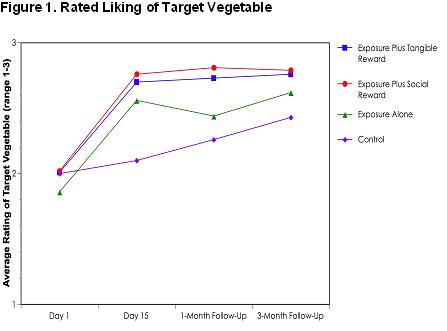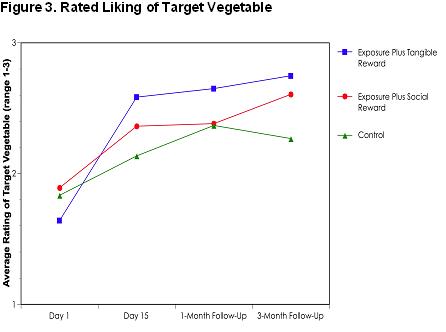Program Synopsis
Designed to increase vegetable consumption among young children by influencing their exposure to and liking of vegetables, this home-based intervention consists of parents introducing the child to a target vegetable for 14 days by presenting the whole uncooked vegetable to the child, talking about how it grows, preparing it in front of the child, offering it to the child, and giving the child a sticker or other reward for trying it. The study showed increases in the liking and consumption of the target vegetable.
Program Highlights
Program Materials
Preview materials
Featured Profile
Learn more about this program and the developer who created it
Program Scores
The Need
A host of negative health outcomes are associated with low consumption of fruits and vegetables. Vegetables are among children's most disliked foods, and their vegetable intake consistently falls short of dietary guidelines. Early childhood is a sensitive period for development of food preferences, with patterns of food refusal commonly beginning around 2 years of age. Food patterns established in early childhood have been shown to track into adulthood. Therefore, it is imperative to increase children's vegetable intake.
Food preferences are developed through exposure to specific flavors. People become more familiar with foods the more they taste them, and familiarity in turn results in greater liking for these foods over time. Research has demonstrated that daily taste exposure can increase children's acceptance of unfamiliar or moderately disliked foods. Several recent studies have extended the repeated exposure protocol by introducing small rewards to encourage children to taste an unfamiliar or disliked food. These findings suggest the addition of small rewards for tasting as part of the exposure protocol, have no adverse effect on outcomes, and may help encourage pickier children to comply.
The Program
Tiny Tastes is a program designed to influence children's liking and intake of vegetables by offering children incentives for tasting one target vegetable each day for 14 days. Different vegetables can be offered over time, but parents are encouraged to focus on one at a time for each 14-day period. To begin, the parent selects a moderately disliked or unfamiliar vegetable for the child to try. At a set time each day (e.g., snack time or just before a meal), the parent presents the vegetable (whole, if possible) to the child, talks about where the vegetable comes from or how it grows, and prepares it in front of the child. The parent then asks the child to taste a small piece of the vegetable, without any seasonings, dips, or dressings. Each time the child tastes the vegetable, the parent rewards the child with tangible non-food items (checkmark on a chart and a sticker) as well as verbal praise. This process is repeated with the same vegetable for 14 days.
In the studies reviewed for this summary, child participants were aged 4-6 (Study 1) and 3-4 (Study 2).
Community Preventive Services Task Force Finding
 This program uses the following intervention approach for which the Community Preventive Services Task Force finds insufficient evidence: school-based programs promoting nutrition and physical activity (Diet and Nutrition). Insufficient evidence means the available studies do not provide sufficient evidence to determine if the intervention is or is not effective. This does not mean that the intervention does not work. It means that additional research is needed to determine whether the intervention is effective.
This program uses the following intervention approach for which the Community Preventive Services Task Force finds insufficient evidence: school-based programs promoting nutrition and physical activity (Diet and Nutrition). Insufficient evidence means the available studies do not provide sufficient evidence to determine if the intervention is or is not effective. This does not mean that the intervention does not work. It means that additional research is needed to determine whether the intervention is effective.Time Required
The intervention is administered over a period of 14 days for each vegetable, and takes a few minutes each day.
Intended Audience
Tiny Tastes is implemented by parents with their young children (ages 3-6).
Suitable Settings
Tiny Tastes is intended as a home-based intervention. It also has been evaluated in school settings.
Required Resources
The program can be purchased through the program website.
For costs associated with this program, please contact the developer, Lucy Cooke. (See products page on the EBCCP website for developer contact information.)
About the Study
Two studies were reviewed for this summary. Study 1 was conducted in a school setting with children in kindergarten and first grade. Study 2 was conducted in the homes of children attending nursery schools.
Study 1
Sixteen kindergarten and first-grade classrooms from eight schools were randomly assigned to one of four study conditions: exposure plus tangible reward, exposure plus social reward (i.e., praise), exposure alone, and no-treatment control. The intervention was administered by trained researchers for 15 school days over a period of 3 weeks, with participants in the intervention conditions scheduled for 12 exposure sessions.
On days 1 and 2, each child in every condition was individually shown six vegetables (carrot, red pepper, sugar snap pea, cabbage, cucumber, and celery). The child was asked to taste a small piece of each vegetable and rate how much he or she liked it using a faces scale, which consists of cartoons of three faces with expressions corresponding to "yummy," "just OK," and "yucky". After the child had tasted and rated all of the vegetables, the researcher asked the child to rank them from 1 (most liked) to 6 (least liked). Each child's target vegetable was the one he or she ranked fourth. The child was then invited to eat as much of the target vegetable as he or she wanted, with intake (in grams) assessed by weighing the dish before and after consumption using a digital scale.
From day 3 to day 14, children in the intervention conditions were seen individually and offered a small piece of their target vegetable each day. Children in the exposure plus tangible reward condition were told that if they tasted the vegetable, they could choose a sticker as a reward. Children in the exposure plus social reward condition were praised if they tasted the vegetable (e.g., "Brilliant, you're a great taster"). Children in the exposure alone condition were invited to taste the target vegetable but received minimal social interaction. Children in the control group did not receive taste exposure to the target vegetable during the intervention period. Children's ratings and consumption of their target vegetable were also assessed on day 15 and at 1- and 3-month follow-up visits.
The study included 99 children in the exposure plus tangible reward condition, 106 in the exposure plus social reward condition, 105 in the exposure alone condition, and 112 in the control condition, for a total of 422 participants. Children were aged 4-6, and 53% were boys.
Study 2
Families who agreed to participate were randomly allocated to one of three study conditions using blocked randomization: exposure plus tangible reward, exposure plus social reward, and no-treatment control. A researcher visited each family in their home to administer the baseline assessment. Children were presented with six different vegetables (carrot, cucumber, white cabbage, red pepper, celery, and sugar snap peas). The children were asked to taste a small piece of each vegetable and then rank them from 1 (most liked) to 6 (least liked). Each child's target vegetable was the one he or she ranked fourth.
After the baseline assessment and the randomization procedure were conducted, the researcher explained the exposure and reward techniques to parents in the intervention groups. Parents in the exposure plus tangible reward condition were asked to offer their child a small piece of their target vegetable every day for 12 weekdays and to tell the child that he or she could choose a sticker for trying the vegetable each time. Parents in the exposure plus social reward condition were asked to offer the vegetable as described above and to praise their child with phrases such as "Brilliant, you're a great vegetable taster" if the child tasted it. Families assigned to the control group did not perform any daily tastings but were told that they would be taught a special technique to help their child eat more vegetables after the last visit. Children's ratings and consumption of their target vegetable were also assessed in the home by a researcher immediately after the intervention period and at 1- and 3-month follow-up visits.
The study included 58 children in the exposure plus tangible reward condition, 59 in the exposure plus social reward condition, and 56 in the control condition, for a total of 173 participants. Children were aged 3-4, and 52.6% were girls. Parents/primary caregivers were 66.5% White, 2.9% Black (African/Caribbean), 5.8% South Asian (Indian/Pakistani/Bangladeshi), and 24.8% other/missing data.
Key Findings
Study 1

- Over the 3-month study, all three intervention groups achieved greater increases in rated liking of the target vegetable compared with the control group (p<.001). There were no significant differences among the intervention groups.

- From day 1 to day 15, all three intervention groups had a significantly greater increase in consumption of the target vegetable compared with the control group (p<.001). Among the three intervention groups, the increase in consumption was greatest for the exposure plus tangible reward group, and there was no significant difference between the other two intervention groups.
- From day 15 through 3-month follow-up, the exposure plus tangible reward group and the exposure plus social reward group had significantly greater increases in consumption compared with the control group (p=.001), and there was no significant difference between the exposure alone and control groups.
Study 2

- Children's rated liking of the target vegetable was significantly higher in the exposure plus tangible reward group than in the control group on day 15 (p=.001) and at 3-month follow-up (p=.001). The exposure plus social reward group had a lower rated liking of the target vegetable compared with the exposure plus tangible reward group, and a higher rated liking than the control group, but these differences were not significant.

- Consumption of the target vegetable was significantly higher in the exposure plus tangible reward group than in the control group on day 15 (p=.001) and at 3-month follow-up (p=.005). The exposure plus social reward group had lower consumption of the target vegetable compared with the exposure plus tangible reward group, and higher consumption than the control group, but these differences were not significant.


